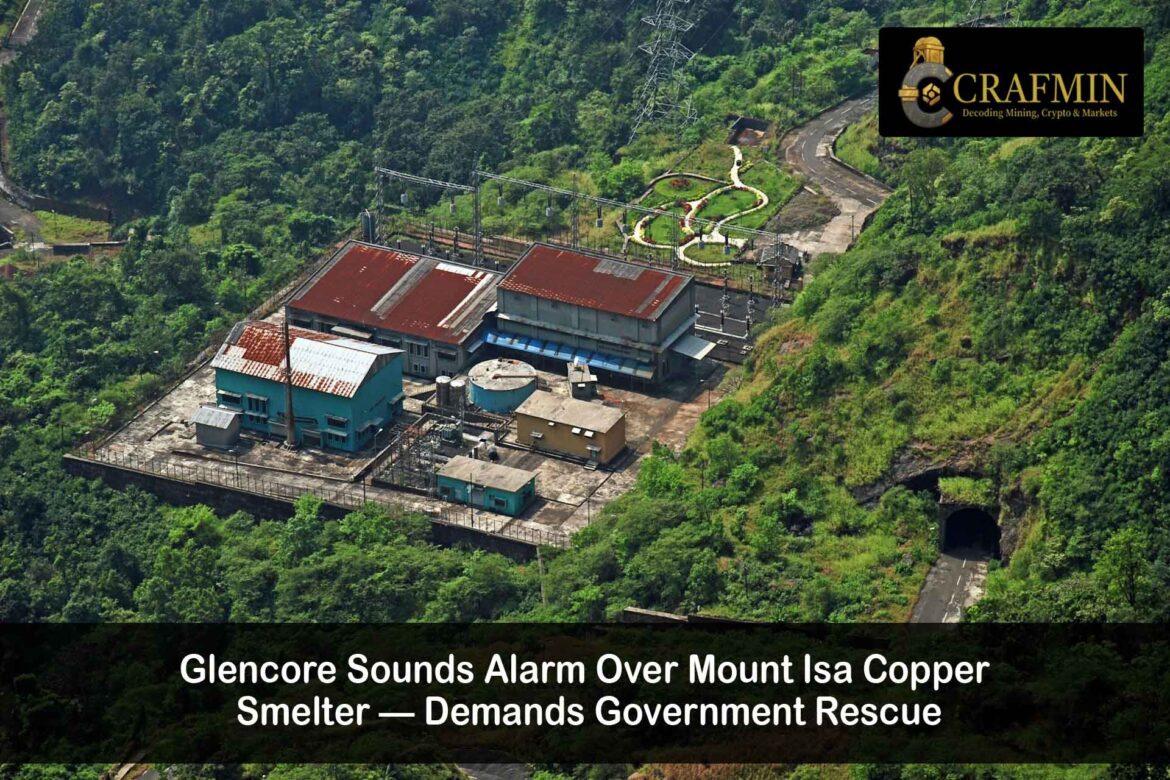
CREDIT: AP Photo/Keystone, Urs Flueeler, file
Summary
- What’s Happening?
It has sent the government an urgent message: its Mount Isa copper smelter and Townville refinery could shut unless liaising with the federal and Queensland governments leads to an A$500-million rescue deal.
- At Risk: Roughly 1,200 people working on site and an estimated 15,000 to 17,000 jobs in the region both on the land directly below the development and in related rail logistics and manufacturing could be at risk.
- Ripple Effect: Fertiliser production chains, equipment servicing and infrastructure in regional Queensland are being put at risk by the crisis.
- From the Field:
“If infrastructure dies here, you’re not just losing a smelter, you’re losing a town,” said Dale Last, an MLA for the Burdekin region.
Why Mount Isa is Important – For Industry and Community
The Mount Isa copper smelter isn’t just a factory; it is a local monument with over a century of history. The site was built in the 1920s as the backbone of the region’s industry, known for hundreds of miles around, building mining towns, schools and health clinics.
In addition to its historical significance, the site levigates anode from local and trucked inland mines into semi-refined copper. The refined output then makes its way to Townsville, where the refinery processes it into export-ready cathode.
What’s Triggering This Crisis
A number of factors have lined up to force the facility onto the chopping block:
1. Aging Infrastructure:
The smelter and refinery are both working beyond their design life, resulting in short maintenance periods and lengthy costly outages.
2. Renewed Decarbonisation Costs:
And with Queensland under pressure to reduce emissions from mining, Glencore’s compliance bill is rising — including installing new technology and paying carbon levies.
3. Transport and Utility Expenses:
Costs for rail and shipping links connecting Mount Isa with Townsville, in addition to energy prices, have surged. Glencore says it needs to maintain the continuing freight subsidies.
4. Global Market Pressures:
Copper has struggled to break out from US$9,200/t, below which benchmark refiners are on significantly lower cost bases, and has rendered the smelter unviable.

Glencore Employees Chart. Credit: Statista
Data Snapshot: Stake and Impact
| Asset / Activity | Direct Jobs | Indirect Jobs | Economic Flow |
| Mount Isa Smelter | ~600 | — | Local payroll, services |
| Townsville Refinery | ~400 | — | Port operations, haulage |
| Rail & Transport Services | ~200 | — | Business contracts |
| Regional Suppliers & Workshops | — | 15,000–17,000 | Ongoing equipment work |
Fertiliser, Manufacturing & Other Fallout
It goes beyond just copper. Approximately 25% of the sulphuric acid consumed at Phosphate Hill, Queensland’s largest fertiliser facility, comes from the Mount Isa smelter product. Incitec Pivot has warned of an acid shortage that would unpeel Australian fertiliser production – and usher in flow-on impacts to agribusiness and explosive making.
And because of mining-related maintenance, local workshops continue to be in demand. If the smelter halves its production or closes, those volumes are gone — and then every panel beater, electrician, supplier, every business in its orbit, is at risk.
Also Read: Speakman Wants AI in Schools. Here’s What That Means for NSW
Political Ripples, Rural Impact
In recent days, Assistant Federal Trade Minister Tim Ayres held private discussions in Canberra, while Minister Scott Stewart toured Mount Isa, meeting workers and advocating for a rescue package.
Local regional leaders like Dale Last have been vocal:
“We’re past the negotiation point. The economy of this region hinges on that plant staying open.”
The Queensland Resources Council and Townsville Enterprise have echoed his calls, citing the “existential threat” to their respective towns, and urging action within 60 days.
What Glencore Wants from Government
While negotiations continue behind closed doors, sources say Glencore is seeking:
- A$300 million in capital upgrades for emissions and processing improvements
- Freight-writing support totalling approximately A$150 million
- A$50 million transition package for workforce and community programs
Industry pundits speculate total assistance could tip over A$500 million, with both federal and state budgets expected to be tapped.
Risks of Inaction
Without a deal in place by late 2025, Glencore warns they will:
- Begin phased closure at Mount Isa & Townsville
- Herald potential redundancy offers
- Trigger a domino effect of business closures
- Risk irreversible destruction of infrastructure (like rail links and acid lines)
While Minister Ayres has described the plant as a “strategic asset,” time is running out.
Looking Ahead: Decisions, Deadlines, and Dialogue
A confidential timeline being circulated suggests:
- By August: Intergovernmental negotiations conclude
- By September: Final smelter viability report released
- By November: Formal deal endorsed or closure plan begins
If no package is supported, retirements of equipment, decommissioning contracts, and staff disengagement could become irreversible.
Final Thoughts
This unfolds as more than a corporate ransom note. It’s a test of how Australia balances regional development, industrial capability, and climate goals. A messy withdrawal risks thousands of livelihoods — across far more than just Mount Isa.
Glencore is clear: lose the smelter, and much more than copper is lost.
What to Watch
- By next month: Federal / state announcements
- Union response: Potential industrial negotiations if job losses announced
- Commodity impact: Copper prices might react to supply concerns
- Local economic data: Townsville / Mount Isa business traffic reports

